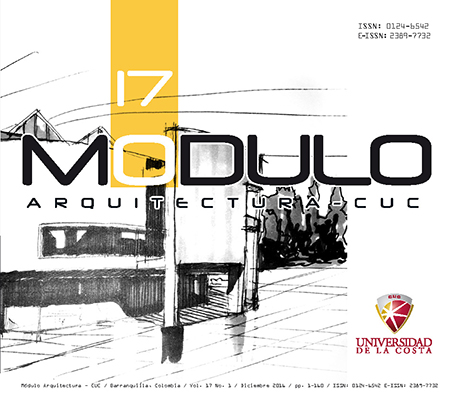Responsibility and dignity in the housing
DOI:
https://doi.org/10.17981/moducuc.17.1.2016.03Keywords:
Dignitas, Restitutas, Sustainability, ResponsibilityAbstract
The present text responds to the question, What criteria and concepts should we, we would
like, and above all, we could be able to explain, understand and transform in order to design,
and above all, to execute a decent housing based public policy effectively and efficiently In
criteria of social responsibility? When it tries to do so, it leaves open other questions, such as:
In addition to the well - known Vitruvian triadic, firmitas - utilitas - venustas, applicable to collective community facilities, what would be the contemporary basis for “other” manifestations or
architectural creations, such as Housing, public space and even the landscape as a cultural
product of distinction? The author assumes a socio-critical epistemological stance, based on a
holistic research methodology; Its main findings are to discover the architectural delusion of form
by form and how to use diatopic hermeneutics as an antidote to it. Therefore, its conclusions
are presented as non-agreements, as a starting point between several authors, the author and
the reader and their relevance is based on the possibility of restoring resilience and dignity as
the new criteria to define sustainability, Both in the form and behavior of human beings, and of
course, in their “dignified” housing in a context of social responsibility.
Downloads
References
Alexander, C. (1969). Ensayo sobre la Síntesis de la Forma. Buenos Aires: Eds. Infinito.
Ascher, F. (2004). Los nuevos princípios del urbanismo. Madrid: Alianza Editorial.
Bachelard, G. (1962). La Poétique de l’espace”. México: Fondo de Cultura Económica, .
Boaventura De Sousa, Santos. (1940), A gramática do tempo: para uma nova cultura política, Volume IV da coleção: Para um novo senso comum. São Paulo: Ed. Cortez.
Dawkins, R. (1941). El Espejismo de Dios. Nueva York: Bantan Press.
Descartes, R. (1650). Oeuvres Philosophiques. Paris: Éditions Classiques Garnier, Bordas.
Feyerabend, P. (1975). Against Method: Outline of an Anarchistic Theory of Knowledge. En M. Radner & S. Winokur, eds., Analyses of Theories and Methods of Physics and Psychology. Minneapolis: University of Minnesota Press.
Gomez, A. (1999). El territorio urbano regional de cara al nuevo milenio: Trayectorias y Perspectivas. Bitácora Urbano/Territorial, 1(4), (pp. 21 – 25).
Harvey, D. (1935). Ciudades rebeldes: Del derecho a la ciudad a la revolución urbana. Madrid: Ed. Akal.
Heidegger, M. (2003). Bemerkungen zu Kunst-Plastik-Raum - Die Kunst und der Raum. Pamplona: Universidad Pública de Navarra.
Izquierdo, A. (1999). Espacio – Temporalidad y Omnijetividad – Una Aproximación Epistemológica. Nómadas, 1(11). 241 - 248.
Perrault, C. (1673). Orden de los cinco tipos de columnas según el método de los antiguos. Recuperado de http://d2aohiyo3d3idm.cloudfront.net/publications/virtuallibrary/0892362332.pdf
Yori, C. (1999). Topofilia o la dimensión poética del habitar. Bogotá DC.: Pontificia Universidad Javeriana.
Zolli, A. y Healy, A. (2012). Resiliencia: Por qué las cosas vuelven a su lugar. Bogotá: Editorial Norma.
Downloads
Published
How to Cite
Issue
Section
License
Copyright (c) 2017 Mauricio Javier Sierra Morales

This work is licensed under a Creative Commons Attribution-NonCommercial-NoDerivatives 4.0 International License.
CC Reconocimiento-NoComercial-SinObrasDerivadas 4.0



 English
English
 Español (España)
Español (España)






